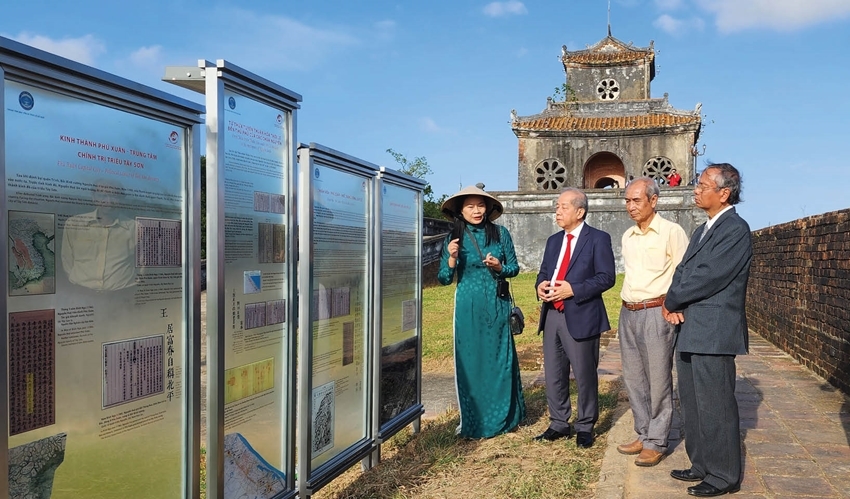“Hue Imperial Citadel - Remaining traces of the past” is the theme of an exhibition organized by Hue Monuments Conservation Center in coordination with National Archives Center I. With two sections, including Thuan Hoa - Phu Xuan - Hue in the flow of history and Hue Imperial Citadel - traces of a dynasty, the exhibition is regularly held in an outdoor space, spanning from The Nhon Gate (Ngan Gate) - the Flag Tower to the Quang Duc Gate.
 |
| The exhibition is regularly held in an outdoor space, spanning from The Nhon Gate (Ngan Gate) - the Flag Tower to the Quang Duc Gate |
An ancient feature
Looking back at history, the land of the Huong River and Mount Ngu once played an important role in the nation's historical progress. From the first half of the 17th century, this place was chosen by the Nguyen lords as the capital. In the early 18th century, Hue became the capital of Dang Trong (the Inner Realm). During the Tay Son dynasty, Phu Xuan land was chosen by Emperor Quang Trung as the capital. After Emperor Nguyen Anh unified the country, Phu Xuan became the capital of the Nguyen Dynasty.
After ascending the throne, Emperor Gia Long "wanted to expand the capital to serve as a gathering place for people from four directions". The capital was opened up with the communes of Phu Xuan, Van Xuan, Dien Phai, An Van, An Hoa, An My, An Bao, and The Lai; and Emperor Gia Long decided on how to build the citadel. The construction of the Citadel began in 1805 and lasted until the 13th year of Minh Mang’s reign (1832). In modern Vietnamese history, Hue Citadel is probably the most massive, large-scale, and completed construction.
Hue Citadel consists of three rounds, which are the Citadel, the Imperial City and the Forbidden Citadel, built according to the Vauban architecture, with 24 fortresses arranged evenly around the Citadel. Outside the Citadel, there is a surrounding system of moats and rivers that both protect the Imperial Citadel and serve as waterway traffic. At the same time, Ngu Ha River is inside the Citadel, which is the only waterway across the Imperial Citadel. Along with that is a gate system of the Imperial Citadel with 10 main gates leading to the outside of the Citadel, one gate connecting to the Tran Binh Dai and two other water gates in the East and the West on Ngu Ha river.
After the ups and downs of history and the changes of time, Hue Imperial Citadel suffered the destruction and damage, some works only have traces left. The ancient feature and the existing buildings of Hue Imperial Citadel are still imprinted in each page of the Imperial Archives - World Documentary Heritage. In 1993, Hue Imperial Citadel of Hue Monuments Complex, was recognized by the UNESCO as a World Cultural Heritage.
"More than 100 Imperial Archives, documents, images, and stories about the construction of Hue Imperial Citadel are reenacted truthfully and vividly through the exhibition, hoping to contribute to "brushing off the dust of time" so that visitors to Hue will get valuable information about an ancient feature of the Ancient Capital," said Director of Hue Monuments Conservation Center Hoang Viet Trung.
"We want to spread the values of the Imperial Archives and stories about building the Imperial Citadel of the ancients... so that the public can better understand the culture and history of this land," expressed Director of the National Archives Center I Tran Thi Mai Huong.
Illuminating many "hidden corners"
Mr. Tran Quoc Bao, a visitor from Hanoi visiting the Imperial Citadel on the occasion of the opening of the exhibition, excitedly shared that the flag tower was a great space for exhibition and viewing of Hue heritages. Mr. Bao also believed that "changing the way of approaching historical data in such a visual and vivid way will "convince" young people to learn about it. From there, they can find the original culture, which is one of the effective ways to preserve and promote heritage values."
According to Mr. Nguyen Xuan Hoa, a cultural and historical researcher about Hue, this is an interesting exhibition. It introduces to the public a system of very reliable documents taken from the Imperial Archives, as well as photos from the 19th century or ancient maps, "telling the story" of Hue Imperial Citadel from the time when Emperor Gia Long built it the capital of the Nguyen dynasty. In particular, the exhibition is held in the space of the Upper Surface of the Citadel rampart. This approach facilitates the conditions to lead and attract the public, opening the way to explore Hue relics in a new direction. Instead of just visiting and admiring the walls, the fortress system, and doing promenades, etc., visitors can also gain a deeper understanding of Hue Imperial Citadel.
According to Mr. Hoa, if we go into details, the exhibition also reveals a lot of valuable information for researchers and heritage lovers, such as the image of Thuong Tu Gate. For those who study the culture and history of Hue, we all know that in front of the citadel's gates, there is a small structure for guards to control people coming in and out, but in old documents, we cannot identify which one. We thought it was the two ‘Ngan’ gates, where the Emperors and Queens went out. However, the images provided by the exhibition prove that Thuong Tu Gate also had that structure. This can be confirmed that in the past, the gate system of the entire South side was not the same as we see today, it was also built up by a very unique structure, which was the guard post right in front of the gates.
"I believe that if we continue to study these documents in depth, they will help illuminate many hidden corners of history, as well as providing data for the restoration of monuments in the future," said researcher Nguyen Xuan Hoa.